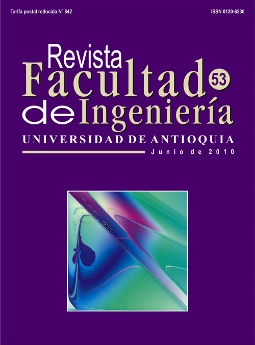Evaluation of the pigment dispersion in acrylic resins for the manufacture of artificial teeth
Keywords:
dispersion of pigments, tinting strength, mechanical millingAbstract
In the first stage of manufacture of artificial teeth, pigments are dispersed in a dry powder composed of fine spherical particles of acrylic resin. This dispersion has different characteristics to the usual dispersion of pigments in liquid resins of paints and coatings, or in the manufacture of plastics. There is a lack of reports on methods of analysis and control of such processes. This article aims to evaluate the method of tinting power, usual in industrial coatings, contrasting the results with the percentage of adhered pigment to the surface of resin by analyzing SEM photographs with digital image processing (DIP) techniques. Three alternative methods based on analysis of the reflectance curves are proposed and discussed. These three methods enable a quicker assessment of the dispersion process than the former ones, and even allow to determine the value of the pigment band gap energy. The tinting power method proves to be the most sensitive to differences in dispersion. Finally, the four methods are applied. Comparison among three milling processes with different collision energies are presented together with their limitations.
Downloads
References
T. C. Patton. Pigment handbook. Characterization and physical relationships. John Wiley and Sons. New York. Vol 3. 1973. pp.1-2.
J. M. Oyarzún. Pigment processing. Physico-chemical principles. Ed. Vincentz Verlag. Hannover (Alemania). 2000. pp.166-181.
J. Winkler, E. Klinke, L. Dulog. “Theory for deagglomeration of pigment clusters in dispersion machinery by mechanical forces”. Journal of Coatings Technology. Vol. 59. 1987. pp. 35-60.
H. Mio, J. Kano, F. Saito, K. Kaneko. “Optimum revolution and rotational directions and their speeds in planetary ball milling”. Int. J. Miner. Process. Vol. 74S. 2004. pp. S85-S92.
P. Kubelka. “New Contributions to the Optics of Intensely Light-Scattering materials”. Journal of the Optical Society of America. Vol 38. 1948. pp. 448-456.
R. A. Smith. Semiconductors. Cambridge University Press. 2ª ed. Cambridge. UK. 1978. pp. 94-102.
P. Parhi, V. Manivannan. “Novel microwave initiated solid-state metathesis synthesis and characterization of lanthanide phosphates and vanadates”. Solid State Sciences. Vol 10. 2008. pp. 1012-1019.
É. Makó, Z. Senkár, J. Kristóf, V. Vágvölgyi. “Optical absorption red and blue shifts in ZnFe2O4 nanoparticles”. Materials Science and Engineering B: Vol 153. 2008. pp. 70-77.
V. Manivannan, P. Parhi, J. Howard. ”Mechanochemical metathesis synthesis and characterization of nano-structured MnV2O6_XH2O”. Journal of Crystal Growth. Vol 310. 2008. pp. 2793-2799.
Downloads
Published
How to Cite
Issue
Section
License
Copyright (c) 2018 Revista Facultad de Ingeniería

This work is licensed under a Creative Commons Attribution-NonCommercial-ShareAlike 4.0 International License.
Revista Facultad de Ingeniería, Universidad de Antioquia is licensed under the Creative Commons Attribution BY-NC-SA 4.0 license. https://creativecommons.org/licenses/by-nc-sa/4.0/deed.en
You are free to:
Share — copy and redistribute the material in any medium or format
Adapt — remix, transform, and build upon the material
Under the following terms:
Attribution — You must give appropriate credit, provide a link to the license, and indicate if changes were made. You may do so in any reasonable manner, but not in any way that suggests the licensor endorses you or your use.
NonCommercial — You may not use the material for commercial purposes.
ShareAlike — If you remix, transform, or build upon the material, you must distribute your contributions under the same license as the original.
The material published in the journal can be distributed, copied and exhibited by third parties if the respective credits are given to the journal. No commercial benefit can be obtained and derivative works must be under the same license terms as the original work.






 Twitter
Twitter